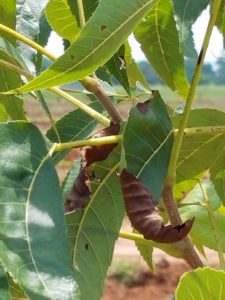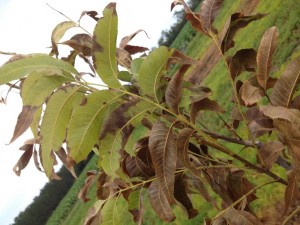I’ve had a lot of calls over the last few weeks regarding leaf scorching on young trees. This is a topic I have written and talked about quite a bit over the last few years. See the following links for details from previous posts: https://site.extension.uga.edu/pecan/2016/06/leaf-drop-pecan-roots-and-soil-temperature/
While there are a number of factors that can lead to leaf scorch on these young trees—-too much water, too little water, high soil temps (which results in poor uptake of nutrients, especially K)—-ultimately, it is a result of too much tree for too little root system. First year trees are under a lot of stress from transplant shock. They lose a large percentage of the root system from digging and root pruning and are placed in a new soil environment. As a result the trees are naturally under a little stress. Those that are planted after the end of February will be in even more stress because they don’t get a chance to start getting some root establishment before budbreak. Also, nursery trees that are 8′ or bigger, especially with large trunk caliper, are subject to even more stress when the top is not pruned hard enough at planting.
This brings me to the topic of root pruning. Yes, we do recommend pruning roots when planting a nursery tree. The research as well as practical experience shows that you get a more vigorous tree when doing so because you are stimulating new root growth. But the key to this is that root pruning makes it extremely important that you also cut the top of the tree back. Especially when planting large nursery trees. The larger the tree you plant, the more of it you need to cut back. In short 8-12′ trees or bigger out of the nursery should be cut back to at least 5′. If you do this, the tree will be much more vigorous and you will have less leaf scorch.
When a tree doesn’t have the root system established to support the tree growth you will see scorching and if there is too great an imbalance between root and shoot, you get die back. Planting in soil that doesn’t drain will do this quicker than anything because the roots drown but anything that limits root growth can lead to this. In addition, freeze injury to the cambium can cause similar symptoms for basically the same reason—the tree can’t get the water and nutrients needed to support it. Also, the low pH and poor fertility of soil behind cleared woods (pines or hardwoods) causes more severe or widespread symptoms of scorch on new trees.
Trees planted into fields that had Cadre applied to peanuts the previous year exhibit die-back, then they start growing again, then they die back again, and repeat the process over and over until the Cadre is washed out of the ground by rainfall. It will usually take one year for it to get completely rinsed from the soil but on heavy clay it may take 2-3 years. Small, low vigor trees planted into this situation usually don’t survive the repeated attempts at regrowth.
Trees planted on good, well drained soil under the conditions of shock mentioned in the second paragraph can develop these symptoms also and they may be present for 3 years or more in some cases. But normally if they are maintained with good overall management practices, they will eventually grow out of it as the root system catches up.
If you have a little scorch but the tree’s vigor is good, just keep good soil moisture and fertility in place.
If loss of vigor or die back occurs, even if there are no leaves present, as long as the cambium under the bark is green (scratch the bark with a pocket knife to see), cut the tree back and most of the time this relieves pressure on the root system and the tree can recover.


